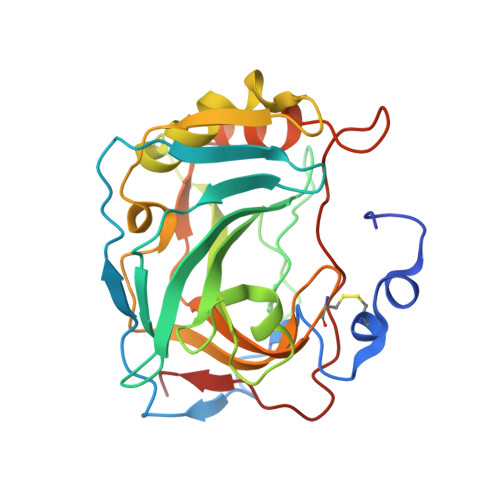An Efficient Expression and Crystallization System of the Cancer Asociated Carbonic Anhydrase Isoform Ix.
Leitans, J., Kazaks, A., Balode, A., Ivanova, J., Zalubovskis, R., Supuran, C.T., Tars, K.(2015) J Med Chem 58: 9004
- PubMed: 26522624
- DOI: https://doi.org/10.1021/acs.jmedchem.5b01343
- Primary Citation of Related Structures:
5FL4, 5FL5, 5FL6 - PubMed Abstract:
Human carbonic anhydrase IX (CA IX) is overexpressed in a number of solid tumors and is considered to be a marker for cellular hypoxia that it is not produced in most normal tissues. CA IX contributes to the acidification of the extracellular matrix, which, in turn, favors tumor growth and metastasis. Therefore, CA IX is considered to be a promising anti-cancer drug target. However, the ability to specifically target CA IX is challenging due to the fact that the human genome encodes 15 different carbonic anhydrase isoforms that have a high degree of homology. Furthermore, structure-based drug design of CA IX inhibitors so far has been largely unsuccessful due to technical difficulties regarding the expression and crystallization of the enzyme. Currently, only one baculovirus-produced CA IX structure in complex with a nonspecific CA inhibitor, acetazolamide, is available in Protein Data Bank. We have developed an efficient system for the production of the catalytic domain of CA IX in methylotrophic yeast Pichia pastoris. The produced protein can be easily crystallized in the presence of inhibitors, as we have demonstrated for several 2-thiophene-sulfonamide compounds. We have also observed significant differences in the binding mode of chemically identical compounds to CA IX and CA II, which can be further exploited in the design of CA IX-specific inhibitors.
Organizational Affiliation:
Biomedical Research and Study Center , Ratsupites 1, LV-1067, Riga, Latvia.


















